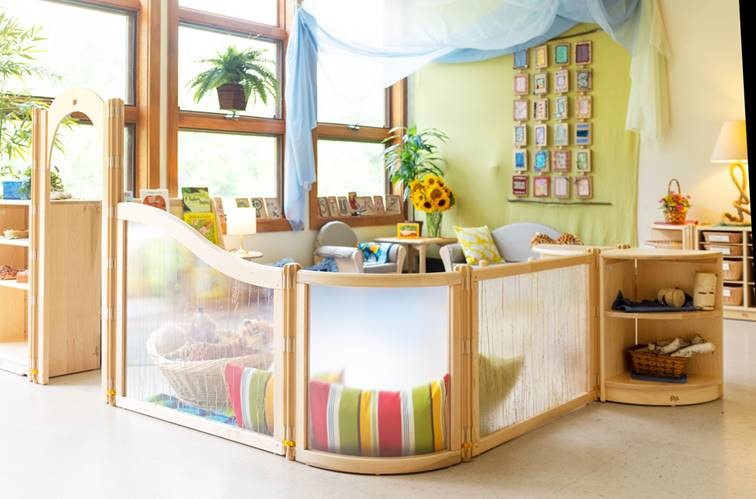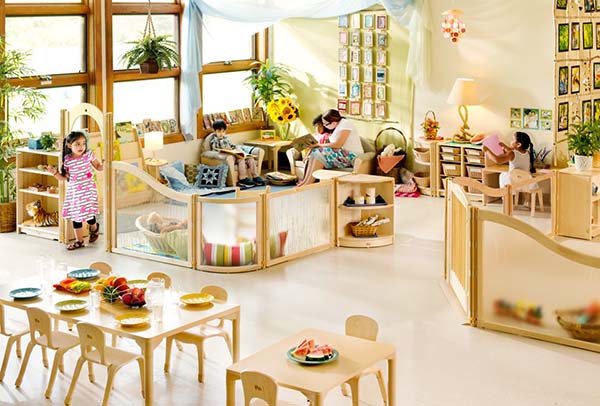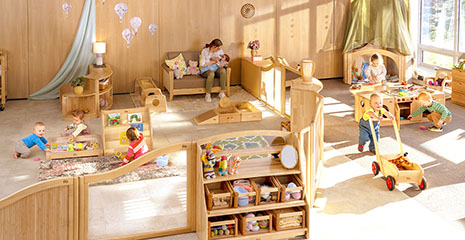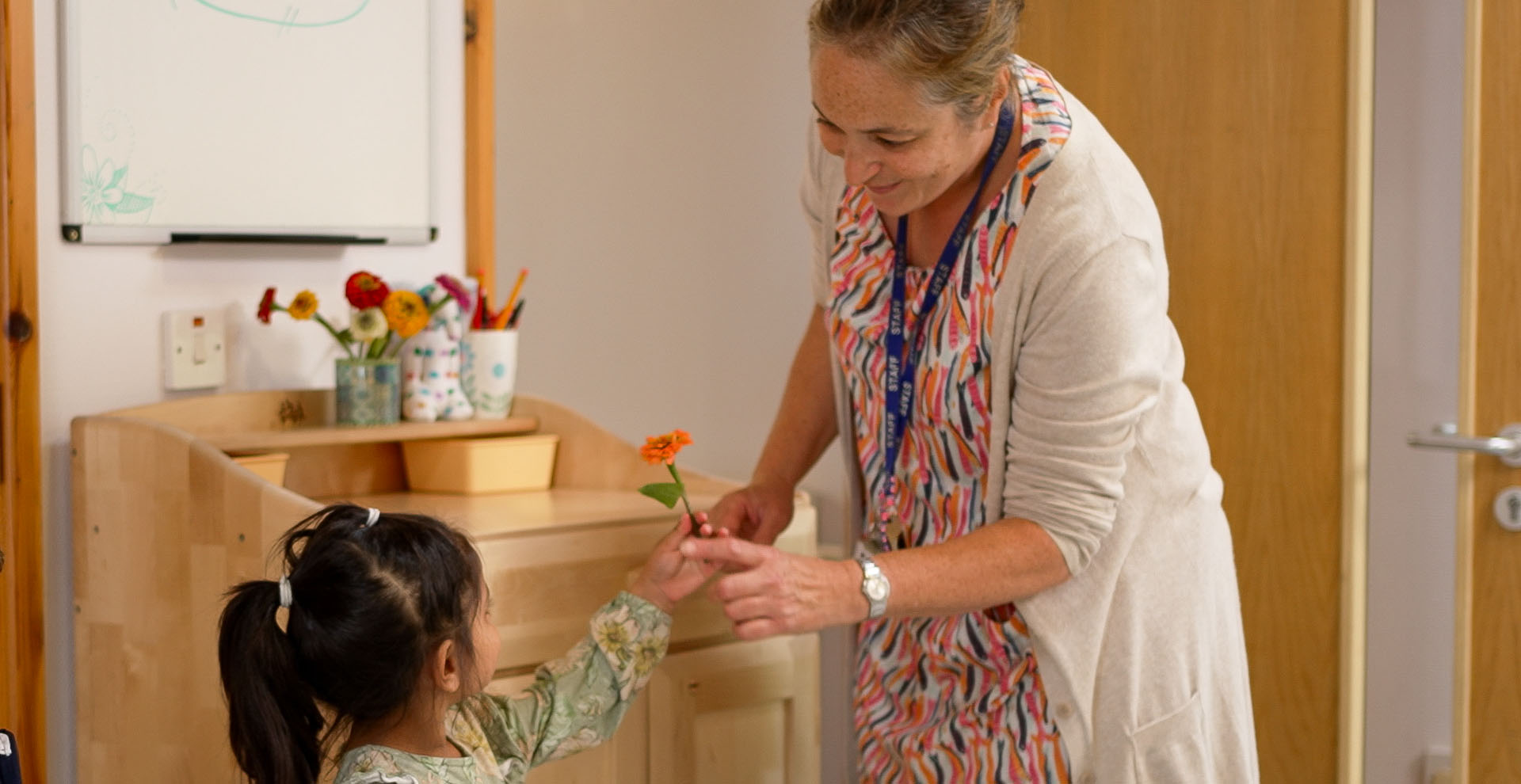Colour and sound in your nursery setting
| July 2021Children’s growth, development, and learning are directly affected by the amount of stimulation in their lives. Consider our responses as adults: how do we eat when we go to McDonald’s? Do we act any differently in a pub? The bright primary colours, hard surfaces, loud music and bright lights of fast food shops create an atmosphere that makes us hurry. In a pub, the lighting is soft, the chairs cushioned, and the music soothing, all enticing us to stay longer. If adults are so affected by the stimulation and mood of their physical environment, how much more do children react? With their still-developing senses of sight, hearing, and feeling, they are super-sensitive.
In an attempt to give our children the best, we may be unwittingly over-stimulating them. We easily overcrowd walls with colourful, busy posters and nursery rooms are often exploding with an abundance of stuffed and plastic toys (some of which beep and squeak). Brilliantly coloured plastic tables and chairs are frequent choices, as they are easy to clean and seem to provide a cheerful splash of colour.
Sound
Sound is one component of the early years environment that is often overlooked. We and our children are constantly pounded with noise: cars, sirens, dishwashers, telephones. Sound waves register in every cell of our bodies (not just our ears). While we adults have learned to “tune out”, children are especially sensitive to auditory stimulation, which may disrupt their play, conversation or thoughts. Their response is often hyperactivity and irritability.
With a bit of creativity, there are ways to dampen undesirable background noise. Drapes, textured wall hangings and throw rugs all absorb sound, and can add a tasteful visual effect to your room. Furniture, lofts, and platforms of varying heights block or redirect sound waves, and can literally “turn down the volume”. If your budget allows, sound absorbent ceiling materials are very effective, too.
Give children a calming auditory focus by introducing interesting, pleasing sounds. Plant bamboos and tall grasses in your outdoor area to rustle in the wind, and hang wind chimes in the covered play area. You may find times to play soft classical music during children’s quieter play times indoors, such as puzzle time, focused play or rest times.
Colour
Just like sound, we respond to colour with our whole body. Colour is often unknowingly the cause of over-stimulation. A kindergarten teacher told me of an event that happened to her many years ago. In her class hyperactivity was the norm; harmonious, sustained play the exception. She consulted her Froebel-trained mentor who came to observe the class. It didn’t take long: the bright orange walls and flashy curtains had to go. In a few days, the children were playing calmly in a pale green room with blue-green curtains. The effect was immediate, and the children were far happier.
Nursery age children are especially responsive to colour. They prefer bright, warm colours. That may be why the hues of their toys and clothes are often primary colours. But just because they are so sensitive, surrounding them with lots of primary colour can be over-stimulating. Hyperactivity, stress, inability to concentrate and even aggressive behaviour can result.
We need to recall the outdoor spaces we loved as children to guide us in interior colour choice. The calming colours of nature – greens, blues, browns, creams – are most conducive to a happy mood. An inside counterpoint might be wooden panelling and furniture with pastel walls, permitting the colour to come from the children’s clothes, toys and artwork.
A month ago, while visiting a nursery, I was shown a recently refurbished 2–3’s room. Despite budget limitations, what they had accomplished was astonishing. The staff proudly showed me compelling “before and after” pictures: garish blue plastic tables had given way to warm wood, while cloth wall and ceiling hangings took the edge off the fluorescent light glare. A fern draped its long fronds over a wooden shelf, and a sea-green rug broke up the blue carpet. Excess furniture had been moved to storage, creating an over-all feeling of invitation, rather than claustrophobia.
The practitioners also told me that a number of their children came from foster homes. Their insecurity resulted in hyperactivity and aggravating behaviour. The changes in the classroom now helped provide a settling and positive influence in their lives which they so badly needed.
Conclusion
Sound and colour are part of everyday life. When we control their presence in the nursery, we can temper the mood of the room toward concentrated and sustained play. Sounds of nature can be introduced to good effect in the early years environment; harsh and discordant sounds can be softened. All children love colour, and should have plenty of it. But we can prevent it from becoming overwhelming by modulating the bright colours of children’s clothes and toys with muted colours in our classroom furniture and decor. Finding the “happy medium” may take some experimentation, but this is well worth the time it takes. Ultimately, achieving balance in sound and colour will contribute to a sense of peace in the nursery, enabling your children to relax and truly feel at home.









